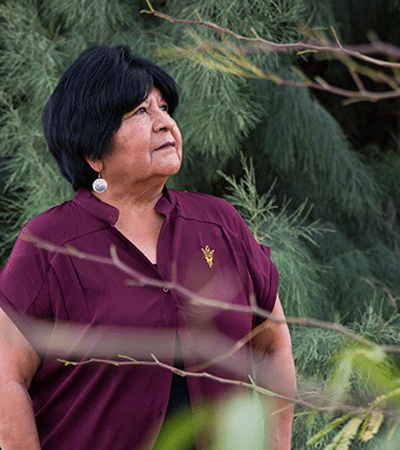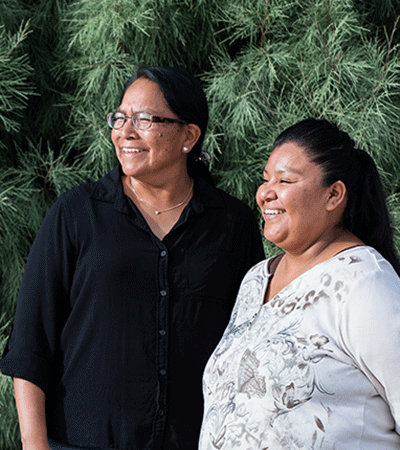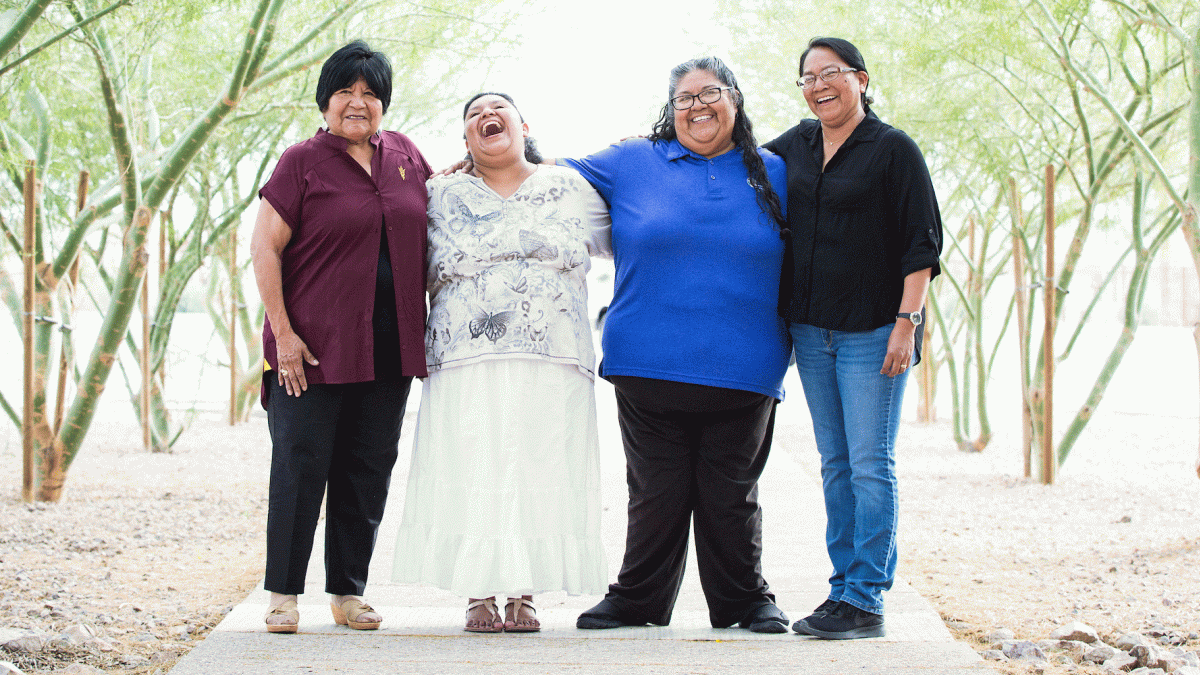In the 1950s, after the Indian Relocation Act was enacted, Priscilla Espinoza’s family moved from the Gila River Indian Community in the far southeast Valley to Southern California.
She met her husband, Phillip, there. They raised three sons. And they felt the sting of discrimination and racism that was commonplace to her people in those days. They became activists, joining the Brown Berets, a group modeled after the Black Panthers in the 1960s.
Espinoza was marching with them in Los Angeles during August 1970 when newspaper editor Ruben Salazar was killed. Salazar was struck by a tear-gas canister fired by a sheriff’s deputy.
“I was there, marching and dodging tear gas,” she said. “It really did make an impact, and a lot changed in Southern California. Because of that big march they started getting more minority teachers, and there was a big push for equal education.”
She put her own higher education, however, on the backburner. Through it all, she never forgot her place among the Akimel O’otham people in Arizona.
“I never lost my identity when I left,” Espinoza said. “I take it with me wherever I go.”
After Phillip, to whom she was married for 42 years, passed away seven years ago, the 69-year-old great-grandmother of two and grandmother of six felt a pull from home and a push from her late husband, who had told her to “keep going, keep living.”
“He was my greatest supporter,” she said.
Now she is among five women from the Gila River Indian Community who call themselves the “soul sisters.” Now, they are graduating grandmas and mothers — and remarkable role models for the people of their community and beyond.

“We incorporate the O’otham language in our visits because a lot of the parents do not know our language. So they learn along with their kids.” — Edwardine Thomas
Ranging in age from 36 to 69, Espinoza, Edwardine Thomas, Nina Allison, Marcella Hall and Starleen Somegustava have completed work on master's degrees in interdisciplinary studies as members of the Gila River Culture and Language Teacher Cohort, a partnership between Arizona State University’s Center for Indian Education and New College of Interdisciplinary Arts and Sciences, and the Gila River Indian Community Tribal Education Department. The first-of-its-kind program trains future teachers on their home reservation with a focus on tribal history and keeping alive the Akimel O’otham language.
The group has formed a tight bond.
“We have all been through a lot of stuff together,” said Thomas, a 56-year-old grandmother of four. “These are my sisters. We’ve gone through a lot of stuff. We’re still going through a lot of stuff. Every week we come to class and we lean on each other.”
All have experienced similar challenges while pursuing their education — from getting back into good study and attendance habits, to feeling a sense of responsibility for their immediate and extended families that is such an important piece of their culture, to balancing work and school, to solving the mysteries that are laptop computers and PowerPoint presentations.
Perhaps the greatest challenge was simply believing that, despite their age and responsibilities, they could achieve an advanced degree from ASU.
“I’ve been going to school off and on since 2014, starting at South Mountain (Community College), and I would say this year has been the most stressful year ever,” said Hall, 36, a cultural instructor for fifth- through eighth-grade students at Sacaton Middle School, about an hour south of Phoenix. She has a daughter and is caring for a niece and nephew.
“I’m handling it, and it’s hard,” she added. “Coming here and letting the ladies know and having their support, it gets easier.”
Espinoza and Thomas are the elders of the group. Each happened upon the cohort by happenstance.
“I always tell people I’m a lifelong learner,” Thomas said. “I’ve been going to school since after high school. I went to college for one year but had to drop out, just for family things. I had to take care of my siblings. So I had to work.”
She has worked for 26 years at the Blackwater Community School in Coolidge. When she attended an in-service teacher training program at the Wild Horse Pass Hotel and Casino, it led her back to school.
“There were people there from South Mountain (Community College), and they asked if any people were interested in obtaining their degrees,” she said. “So that’s where it started.”

“I’m so proud of who I am and proud of what I represent to the people here. They trust me because they know I’m a member of the community, too. So my heart is full.” — Priscilla Espinoza
Now, she is the only member of her family to earn a college degree. Her work at Blackwater focuses on making home visits to people in the community and working with parents and children to reach child-development milestones in gross and fine motor skills and language.
“We incorporate the O’otham language in our visits because a lot of the parents do not know our language,” she said. “So they learn along with their kids.”
She said her ultimate goal is to establish a full-immersion school in the Gila River Indian Community that all of the soul sisters might someday work at.
To that end, the women will join forces this summer to bring together members of the community’s seven districts for a camp that would immerse participants in the O’otham language and culture.
“We’re going to try to do it for three weeks and see how that goes,” Thomas said. “The rest of my cohort members are going to be in on that, too.
“It’s going to be limited to about 10 families per district, and hopefully this will be like a steppingstone for other people to come and join our group, because we’re open to anyone helping us — other community members that are fluent in language or dances or basket making.”
When Espinoza returned to the area to be near one of her sons living in Maricopa, she paid a visit to the Gila River Indian Community Governance Center to complete some paperwork. She and her husband had hoped to retire in the community.
“I had retired from a school district in California, where I was a special education (instructional assistant),” she said. “I was at the governance center to talk to a lady about my paperwork. I wasn’t looking for a job. This young lady was putting up flyers that said ‘special needs (teacher) urgently needed.’
“I said, ‘I used to do that for years.’ Long story short, they interviewed me that day, got my paperwork and hired me on the spot.”
She was asked to work with a young boy with cerebral palsy, who couldn’t walk or talk.
“He could only say ‘mama’ and ‘no,’ ” she said. “I put all my energy into this little boy. ...
“I would see him every morning and say, ‘Good morning, what is your name? My name is Priscilla.’ I said that over and over for six months. One morning I said, ‘Hi, buddy,’ and he looked at me and said, ‘Hi, ’scilla!’ Oh my gosh, I knew then that this is it.”
Gregory Mendoza, who was Gila River Indian Community governor at the time, told her he had gotten a report about her work with the young boy, who now uses a walker.
“He said, ‘I want you to get into this program we have going on, this cohort. We want you to get your degree. We need people like you to help our people here.’ So that was it,” Espinoza said.
“I’m so proud of who I am and proud of what I represent to the people here. They trust me because they know I’m a member of the community, too. So my heart is full.”
The women in the cohort — many of whom are able to participate because of private giving — agree that they are motivated most by what they represent for their families and community members. Espinoza said the cohort members hope their successes will “snowball.”
“When family members see each one of us, the five of us, I think it will trickle down,” she said. “It will snowball, pick up momentum. That’s what we’re hoping for.”

“I told myself I had to get back on track. You do it for your kids. You do it for your family. You’re that role model. You’re that example.” — Nina Allison (left, pictured with fellow cohort member Marcella Hall)
“I tell my students, ‘Don’t be a statistic,’” Hall added. “We have a lot of high school dropouts, and not many of our people are going to college. I say, ‘Make your people proud. Make your family proud of you. We need our people in our communities sitting in the seats we are in as teachers, as educators, as tribal council members. You are all going to be filling our seats.’”
Allison, a mother of four and grandmother of three, briefly stopped her studies in the program when a nephew was killed in a car accident. He had just graduated from high school.
The desire to set an example for others kept her from giving up.
“I didn’t do homework. I didn’t do readings. That was a struggle for me,” she said. “... I told myself I had to get back on track. You do it for your kids. You do it for your family. You’re that role model. You’re that example.
“You have ups and downs and have struggles, but you go on.”
Thomas tells young people to get their education while they’re young instead of waiting like the members of the cohort.
“If I could turn back time, I wish I would have stayed in school and finished (college) after high school,” she said.
“(I tell them) ‘You can do it. Just set your priorities straight and know your family will always be behind you.’”
The Akimel O’otham language
In 2009, the Gila River Indian Community adopted an orthography — a system of written words — for their Akimel O’otham language. Keeping that language alive is part of the mission of the Gila River Culture and Language Teacher Cohort.
A sampling of words from the language:
- Soith (pronounced: so yeth) — love
- Sha pai masma (pronounced: sha pie masama) — How are you?
- Sape (pronounced: saw pa) — fine
- Tho epom ñei (pronounced: do umpam nyeh) — will see you again
- Je’e (pronounced: j’uh) — mother
- O:g (pronounced: awg) — father
- Ga ga’a (pronounced: ga ga ah) — paternal grandmother
- Lu lu’u (pronounced: luu luu ooh) — maternal grandmother
- Vosk (pronounced: vawsk) — paternal grandfather
- Ba ba’a (pronounced: ba ba’a) — maternal grandfather
Written by Bob Young; this story originally appeared in the summer issue of ASU Thrive magazine. Top photo: (From left) Priscilla Espinoza, Marcella Hall, Edwardine Thomas, Nina Allison and (not pictured) Starleen Somegustava have formed a close relationship through the Gila River program. Photos by Deanna Dent/ASU Now
More Arts, humanities and education

ASU professor's project helps students learn complex topics
One of Arizona State University’s top professors is using her signature research project to improve how college students learn science, technology, engineering, math and medicine.Micki Chi, who is a…

Award-winning playwright shares her scriptwriting process with ASU students
Actions speak louder than words. That’s why award-winning playwright Y York is workshopping her latest play, "Becoming Awesome," with actors at Arizona State University this week. “I want…

Exceeding great expectations in downtown Mesa
Anyone visiting downtown Mesa over the past couple of years has a lot to rave about: The bevy of restaurants, unique local shops, entertainment venues and inviting spaces that beg for attention from…


